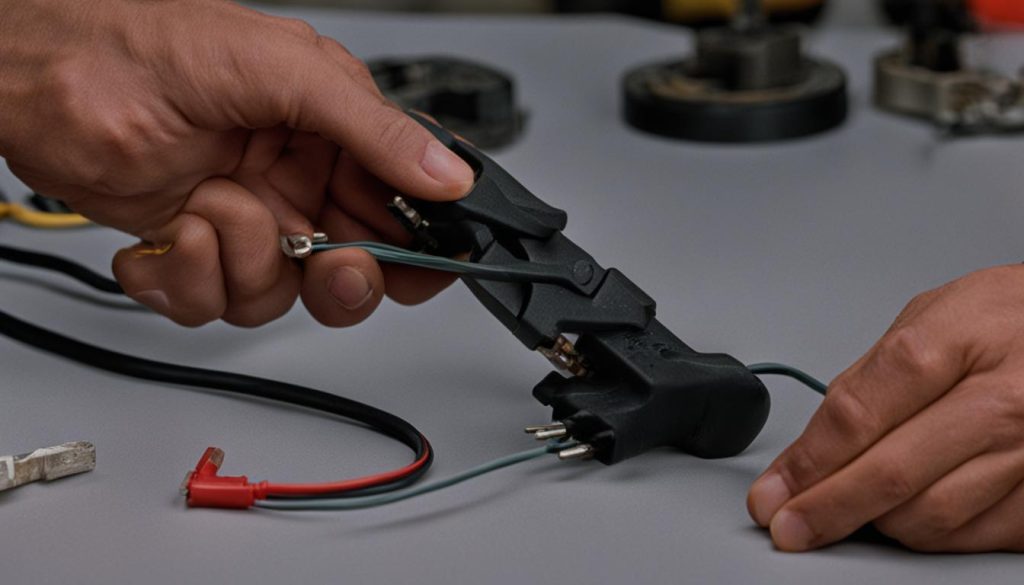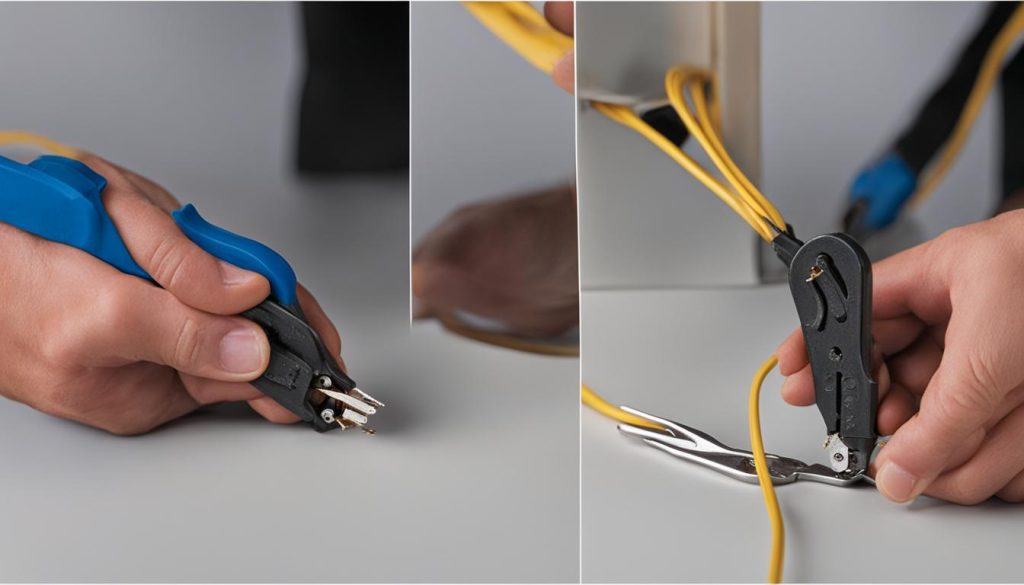Extension cords are a convenient way to extend the reach of electrical devices, but over time they can become damaged and unsafe. If your extension cord plug has seen better days, it’s important to replace it to ensure proper functionality and eliminate potential hazards. In this guide, we will show you how to replace an extension cord plug easily and safely.
Key Takeaways:
- Extension cords can become damaged over time, necessitating plug replacement for safety.
- Choose a plug that is suitable for your specific cord type, such as a grounded three-prong plug or a two-prong polarized plug.
- To replace the plug, you will need tools such as wire cutters, utility knife, wire strippers, and a replacement plug.
- Ensure that the replacement plug has the same amperage and voltage ratings as the original cord.
- Follow step-by-step instructions on how to remove the old plug and install the new one, ensuring proper wiring and tight connections.
Tools and Materials Needed
When it comes to replacing an extension cord plug, having the right tools and materials is essential. Here’s a list of what you’ll need:
Tools:
- Wire cutters
- Utility knife
- Wire strippers
- Phillips screwdriver
Materials:
- A replacement plug
With these tools and materials, you’ll be equipped to safely remove the old plug and install the new one, ensuring that your extension cord is in good working condition.
Removing the Old Plug
To replace the plug on your extension cord, you need to begin by safely removing the old plug. Follow these steps to ensure a successful removal:
- Before you start, always make sure that the cord is unplugged from any power source to avoid electrical hazards.
- Using wire cutters, carefully cut off the old plug from the cord. Take your time to ensure a clean cut.
- Inspect the cord for any damages or frayed wires. If you notice any, use the wire cutters to remove the damaged portion of the cord.
- Slide the new plug over the cut end of the cord temporarily. For plugs with two parts, only slide the outer shell onto the cord at this stage.
Removing the old plug is an essential step in the process of replacing an extension cord plug. By following these simple steps, you can safely remove the old plug and prepare the cord for the installation of a new one.
Tools and Materials Required for Removing the Old Plug
| Tools | Materials |
|---|---|
|
|
Installing the New Plug
Now that you have removed the old plug, it’s time to install the new one. Remember, safety is always a priority when handling electrical components. Follow these steps to ensure a proper installation:
- Cut partially through the outer jacket of the cord using a utility knife, being careful not to cut through the insulation on the cord wires.
- Split the jacket and trim off any loose parts.
- Strip about 3/4 inch of outer insulation from the end of each conducting wire inside the cord using wire strippers.
- If possible, tie the white and black cord wires into an underwriter’s knot. If not, secure them tightly with the plug’s clamping device.
- Using a screwdriver, loosen the terminal screws on the plug.
- Wrap the bare end of the black wire clockwise around the brass terminal and tighten the screw.
- Connect the white wire to the silver terminal and the green wire to the ground screw.
- Double-check all connections to ensure they are tight and secure.
By following these steps, you will successfully install the new plug on your extension cord. This ensures a safe and reliable connection for your electrical devices.

Expert Tip:
When connecting the wires to the new plug, make sure to wrap them tightly around the terminal screws. Loose connections can lead to electrical hazards and unreliable performance.
Finishing the Installation
Now that you’ve replaced the old plug with a new one, it’s time to secure it in place and ensure a safe connection. Follow these steps to complete the installation:
1. Securing the New Extension Cord Plug:
Using a screwdriver, tighten the cord clamp onto the cord. This will hold the plug firmly in place, preventing any accidental disconnections.
2. Assembling the Plug:
If your plug consists of two parts, join the outer shell with the wired portion using the provided screws. Make sure the connection is secure, as this will protect the cord’s internal wiring.

With these final steps, you have successfully finished installing the new extension cord plug. The plug is now securely attached to the cord, providing a safe and reliable power connection.
Next, we’ll cover the testing process and important safety precautions to follow when using your newly replaced extension cord plug.
Testing and Safety Precautions
Now that you have successfully installed the new extension cord plug, it’s important to perform a few tests to ensure everything is working correctly and to follow safety precautions to prevent any potential hazards.
First, plug the newly installed plug into a three-prong receptacle. Then, use a plug-in circuit tester to check if the wires are correctly connected and if the cord is grounded. This step is crucial for ensuring the safety and proper functioning of the cord.
Once you have confirmed that the cord is working properly, congratulations on successfully replacing the extension cord plug! However, it’s crucial to remember the essential safety precautions when replacing a plug.
Make sure the cord is always unplugged from any power source before starting the replacement process. This eliminates the risk of electric shock. Additionally, using the correct tools, such as wire cutters, utility knife, and wire strippers, ensures that the replacement is done safely and effectively. Lastly, double-check all connections for tightness to prevent any electrical hazards that may arise from loose connections.
FAQ
How do I replace an extension cord plug?
To replace an extension cord plug, start by cutting off the old plug from the cord using wire cutters. Then, slide the new plug over the cut end of the cord and follow the step-by-step guide mentioned above for safe and proper installation.
What tools and materials do I need to replace an extension cord plug?
You will need wire cutters, a utility knife, wire strippers, a Phillips screwdriver, and a replacement plug.
How do I safely remove the old extension cord plug?
Before removing the plug, ensure that the cord is unplugged from any power source. Then, cut off the old plug with wire cutters and remove any damaged portion of the cord.
How do I install the new extension cord plug?
After cutting off the old plug, slide the new plug over the cut end of the cord. Make sure the replacement plug has the same amperage and voltage ratings as the original cord. Connect the black wire to the brass terminal, the white wire to the silver terminal, and the green wire to the ground screw. Double-check all connections for tightness.
How do I secure the new extension cord plug?
Using a screwdriver, tighten the plug clamp onto the cord. If the plug is in two parts, join the outer shell with the wired portion and tighten the cord clamp on the body. This will securely hold the new plug in place.
How do I test the new extension cord plug and what safety precautions should I follow?
After installing the new plug, plug it into a three-prong receptacle and use a plug-in circuit tester to check if the wires are correctly connected and if the cord is grounded. Remember to follow safety precautions, including unplugging the cord from any power source while replacing the plug and ensuring all connections are tight to prevent electrical hazards.


